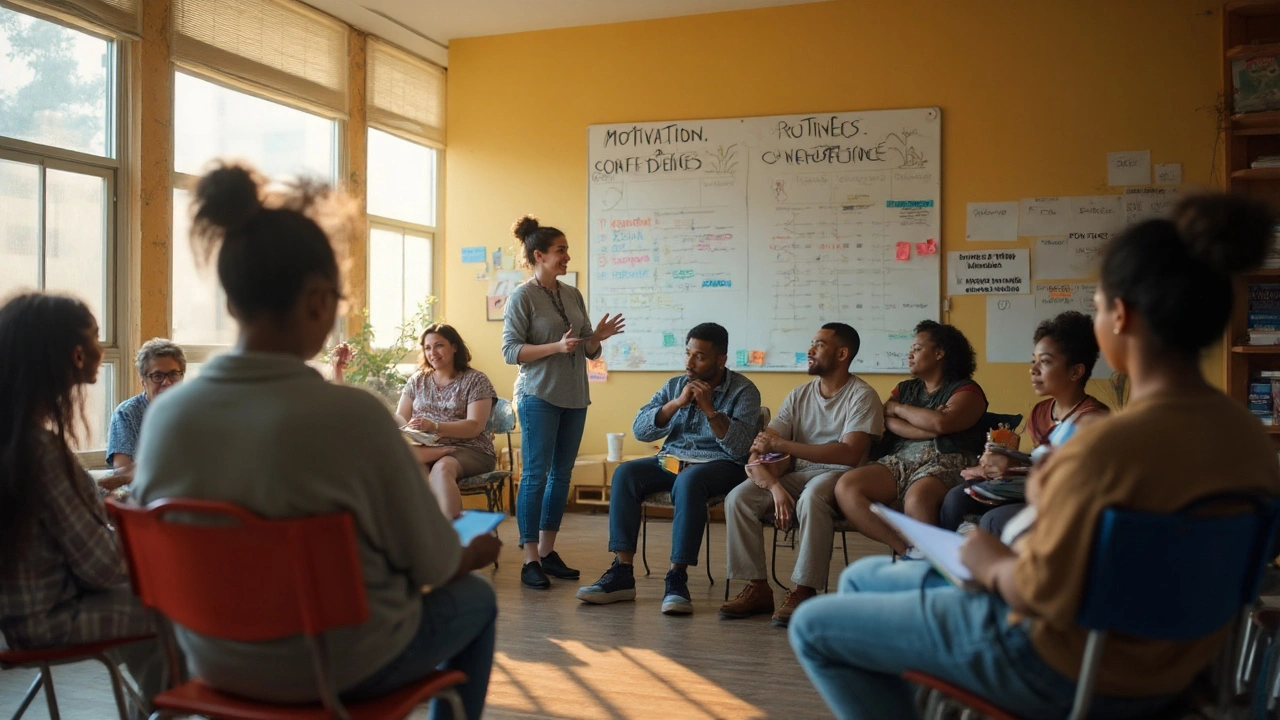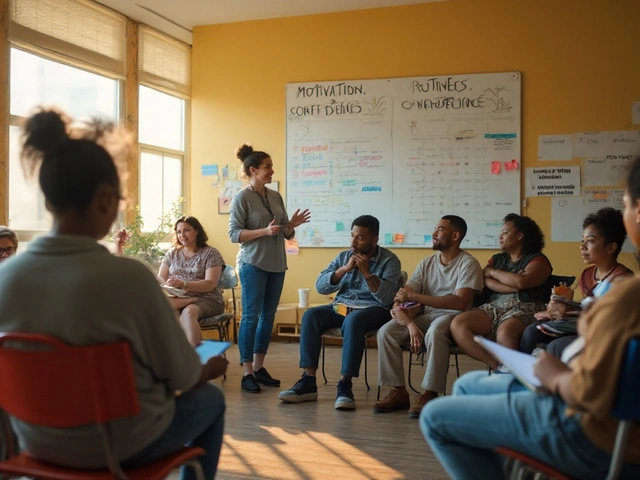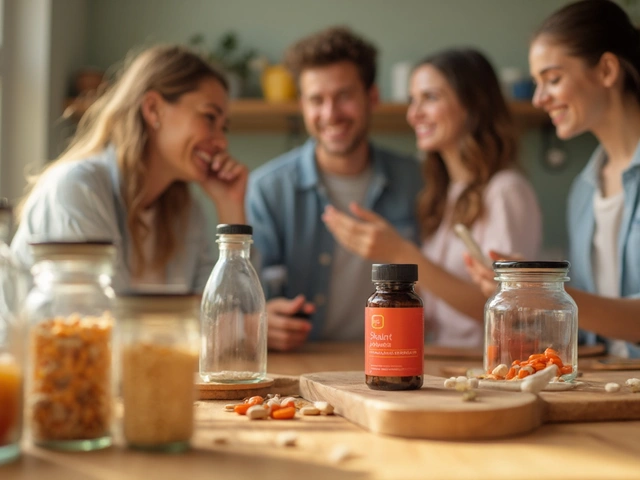Here’s the hard truth: ADHD can feel isolating even when your calendar is full. That’s the gap ADHD support groups fill-practical help, honest empathy, and steady accountability you don’t get from a quick appointment or a tips list. They won’t replace therapy or medication, but they can make both work better. Expect real people, real setbacks, and skills you can actually use on a Tuesday night when your brain would rather scroll.
What you likely want to get done:
- Figure out the specific benefits of joining a group so it’s worth your time.
- Know what actually happens in meetings-no awkward guessing.
- Pick a group that matches your goals (focus, routine, social support, or skills).
- Start without overwhelm and get value from the first session.
- Measure if it’s working and know when to switch groups.
- TL;DR: Support groups improve motivation, routines, and self-acceptance. They add accountability and practical hacks, especially for adults juggling work, study, and family.
- Evidence: UK guidance (NICE NG87) supports psychoeducation and group-based support as part of ADHD care. Trials of group skills programs for adults (e.g., Young et al.) show gains in organization, time management, and quality of life. Peer support research across mental health shows small-to-moderate benefits for hope, self-efficacy, and adherence.
- What to expect: 60-90 minutes, check-ins, a focused topic (time, sleep, procrastination), a tool to practice, and quick wins. No pressure to share on day one.
- How to choose: Match the format to your goal-peer-led for community and momentum; clinician-led for structured skills; online for convenience; in-person for connection.
- Quick start: Set one goal, try three sessions, use a 10-minute Sunday plan, and track a tiny metric (e.g., start times) for two weeks.
Why ADHD support groups work (and the real benefits you can expect)
ADHD isn’t just about attention; it’s about self-regulation, time, emotion, and working memory. Groups help by building scaffolding around those weak spots. You borrow the structure, strategies, and optimism from others until it becomes yours.
Emotional safety, not pep talks. Most adults with ADHD carry a quiet stack of shame from missed deadlines, late taxes, and “you’re so capable” speeches. A good group normalizes the pattern, not just the person. This lowers stress and frees up working memory-so you can actually use the skills you already know.
Accountability that isn’t heavy-handed. It’s easier to start a task when someone expects an update. A 30-second check-in (“I’ll send that email by 8 pm”) often beats an app or a planner. Many members report starting tasks 15-20 minutes sooner when they’ve said it out loud with a date and time attached.
Fast, practical strategy-sharing. Instead of wading through generic advice, you get context-rich examples: “I prep my meds next to the kettle,” or “My calendar has a 2 pm alarm that says ‘start to start’ for hard tasks.” These peer tweaks are often the difference between trying a tool and sticking with it.
Better treatment follow-through. NICE guidance in the UK includes psychoeducation and group support as part of comprehensive care for ADHD. Group-based programs for adults, like those studied by Susan Young and colleagues, show improvements in organization, emotional control, and quality of life versus usual care. Peer support research across mental health (including JAMA Network and Cochrane analyses) consistently finds small-to-moderate gains in hope, self-efficacy, and adherence to care-exactly where ADHD struggles live.
Identity and self-acceptance. There’s relief in hearing, “Oh, you do that too?” When you see patterns, not personal failings, you try again sooner. That speeds up the trial-and-error loop needed to tailor ADHD strategies.
Everyday wins that add up. Think simple but sticky outcomes: fewer late fees, fewer no-show days, more on-time starts, one extra gym visit per week, fewer arguments about chores. It isn’t dramatic; it’s consistent. That’s where life changes.
Quick story: I’m in Manchester, and I joined a Tuesday evening group in a library room because my “I’ll do it later” problem was eating my weekends. The group introduced a “2-minute start” rule and a Sunday 10-minute plan. My cat, Whiskers, now hears the microwave timer and knows I’m mapping the week. That tiny ritual cut my missed emails in half within a month.
Common benefits you can measure:
- On-time starts for one tough task per day
- Fewer forgotten appointments (add a buddy reminder)
- More consistent meds or supplement routines
- Less task-switching mid-morning
- Quicker recovery after disruptions (kids, emails, noise)
| Benefit | What it looks like in real life | How groups create it | Metric you can track |
|---|---|---|---|
| Accountability | Starting hard tasks earlier | Micro-commitments + buddy check-ins | Start time vs. planned time (minutes) |
| Emotional regulation | Fewer spirals after setbacks | Normalising + reframing scripts | Number of “stuck” episodes per week |
| Executive function | Consistent routines | Shared templates and prompts | Days you followed a simple routine |
| Skill use | Actually using planners/timers | Live demos + peer tweaks | Times per day tools used |
| Self-acceptance | Less shame, more tries | Stories from people like you | Attempts before giving up |

How to get real value from your first three sessions
Walking into a group can feel like the first day at a new gym. Here’s a simple plan that removes guesswork and gets you benefits fast.
Before you go
- Pick one goal. Example: “Start my workday on time 3 days a week.”
- Choose a tiny metric. Example: “Minutes late to first task.”
- Set your baseline. Track it for three days before you attend.
Session 1: Observe and commit small
- Listen first. If you share, keep it to 60 seconds: challenge, one example, what you’ve tried.
- Grab one tool only. Timer, body double, Sunday 10-minute plan, or a cue (sticky note on the kettle).
- Make one micro-commitment with a time and place. Example: “Set my 2-minute timer at 8:55 am Mon-Thu.”
- Ask for a buddy nudge. A quick message the next morning beats a vague promise.
Between sessions
- Use the 3×3 rule: 3 days, 3 tries, 3 minutes each try. If it still doesn’t stick, swap the tool.
- Make the barrier smaller. If you didn’t start, ask why. Too early? Make it 10:00 am. Too long? Try one minute.
Session 2: Tune and personalise
- Report with a number. “I was 12 minutes late on average; one day on time.”
- Ask for one tweak. “What do you change when the 2-minute timer doesn’t work?”
- Swap or layer. Keep the timer and add a cue (move your laptop charger to your desk the night before).
- Set a second micro-commitment. Example: “Night-before setup at 9:30 pm, phone reminder.”
Session 3: Lock the ritual
- Make it visible. Write your 3-step morning start on a sticky: water, open laptop, 2-minute timer.
- Add a reward. Coffee only after you start the timer. Yes, bribery works.
- Plan for bad days. “If I miss the 9:00 start, I do a 10:30 restart-no guilt spiral.”
- Decide to stay or switch. If your metric hasn’t moved at all, try a different format or facilitator.
Heuristics that keep you on track
- 70/30 sharing: spend 70% on the plan, 30% on the story.
- Start-to-start beats finish-to-finish. Measure starting on time, not finishing perfectly.
- People first, tools second. A supportive room beats a perfect app you won’t open.
- Three-session rule. Give any group three tries before deciding.
What a typical meeting looks like
- Check-ins (10-15 min): names, quick wins, one challenge.
- Topic (20-30 min): e.g., procrastination, sleep, medication routines, paperwork dread.
- Skill practice (10-20 min): live demo of a timer, calendar block, or a “body double” co-work plan.
- Commitments (5-10 min): one action, where and when, buddy assigned.
- Wrap (5 min): resources, next meeting, gentle “see you next week.”
Red flags to avoid
- One person dominates every week; no boundaries from the facilitator.
- Shame-y advice: “Just try harder.” Hard pass.
- Unverified medical claims or pressure to ditch prescribed treatment.
- No structure at all after several sessions; you feel worse when you leave.
Green flags that signal a keeper
- Clear agenda and time-keeping, but warm.
- Action focus: everyone leaves with a small next step.
- Diverse voices; space for late-diagnosed adults.
- Practical takeaways: templates, scripts, or checklists you can use tomorrow.

Find the right group (UK-friendly), compare formats, and get unstuck
Not every group fits every brain. Match the format to your goal and your life. If you’re in the UK, you’ll see a mix of NHS-run psychoeducation groups, charity-led peer groups, and private clinician-led skills groups, plus online communities that meet on video.
Where to look (UK and beyond)
- NHS services: ask for adult ADHD psychoeducation or group skills as part of your care plan.
- Charities and NGOs: ADHD Foundation (Liverpool), local ADHD groups listed by councils, national organisations that run meetups.
- Universities and workplaces: staff/student disability services often host ADHD circles.
- Online: moderated communities that offer live video groups, co-working, and topic rooms.
| Format | Best for | What you get | Typical cost (UK) | Watch-outs |
|---|---|---|---|---|
| Peer-led, in-person | Community, momentum, local tips | Check-ins, shared hacks, buddy system | Free to £5-£15 per session | Quality varies; need a clear facilitator |
| Clinician-led skills group | Structure, evidence-based tools | Psychoeducation, CBT/skills modules | NHS: free; Private: £30-£60 per session | Less social time; waitlists in NHS |
| Online video group | Convenience, flexible schedules | Topic rooms, co-working, global peers | Often £10-£25 per month | Screen fatigue; need good moderation |
| Co-working/body doubling rooms | Task starts, focus bursts | Pomodoro cycles, cameras on/off | Free to low subscription | Less discussion; more doing |
Decision guide
- If your main pain is starting tasks: choose co-working or peer-led with strong accountability.
- If you want structured skills: look for clinician-led or NHS psychoeducation groups.
- If you crave community: peer-led in-person often feels most connecting.
- If you travel or have caring duties: online wins for reliability.
How to vet a group in 10 minutes
- Read the ground rules: time limits, confidentiality, “no medical advice” policy.
- Ask about structure: “What does a typical session look like?”
- Check facilitator experience: lived experience and/or clinical background.
- Look for guardrails: how they handle monopolising or triggering topics.
- Trial plan: Can you try three sessions before committing long-term?
Simple checklist to bring to your first meeting
- One clear goal (write it down)
- One metric to track (minutes late, days completed, number of starts)
- Phone timer or simple analog timer
- Notebook or notes app for commitments
- A buddy ask (“Can we check in Wednesday at 9?”)
Mini-FAQ
- Will a support group replace therapy or meds? No. Think of it as a booster. NICE and clinical studies back group-based education and skills as add-ons to core treatment.
- What if I’m late or talk too much? Good groups expect that ADHD shows up in the room. Clear facilitation keeps things kind and on time.
- Can I get worse? You shouldn’t. If you leave feeling shamed or confused two weeks in a row, that’s a sign to try a different group.
- How long until I see benefits? Many people notice small wins in 2-3 sessions if they track one metric and make micro-commitments.
- Is online as good as in-person? For starting tasks and consistency-often yes. For connection, in-person can feel richer. Try both.
Evidence notes (plain English)
- NICE Guideline NG87 (UK) places psychoeducation and group support within ADHD care for adults and young people.
- Group skills programs for adults with ADHD (e.g., randomized trials led by Susan Young and colleagues) show improvements in executive skills and wellbeing compared with usual care.
- Peer support across mental health (Cochrane and JAMA Network analyses) shows small-to-moderate gains in hope, empowerment, and service engagement-helpful in ADHD where motivation and follow-through are daily battles.
Next steps and troubleshooting
- If you’re newly diagnosed: Start with psychoeducation or clinician-led skills to learn the ADHD model. Add a peer group for real-world hacks.
- If meds help but routines don’t stick: Prioritise peer-led groups with co-working sessions. Track morning start times and night-before setup.
- If you’re a student: Look for campus-run groups. Use a body-doubling room during assignment weeks.
- If you’re a parent of a child with ADHD: Many groups mix parent and adult ADHD. Ask if they split topics so you get time for your own tools.
- If you tried and bounced off: Switch formats, not the goal. Keep your metric, try a different facilitator, and give it three sessions.
One last nudge: pick one small experiment this week. Ten minutes on Sunday to map your week, a buddy text at 8:55 am, or a two-minute timer to start the thing you keep dodging. The group gives you the nudge, but you’ll feel the win. And once you feel it, you’ll want the next one.









Comments (10)
ravi kumar
September 5, 2025 AT 19:56 PMAccountability works, period - saying you will do something out loud moves the needle more than another app ever will.
In my experience it's the tiny rituals that win: a buddy check, a 2-minute start, a visible night-before setup. Those micro-commitments create a scaffolding around the parts of the day that keep collapsing. If you want blunt advice, try a peer-led co-working slot twice a week and force the check-in. Keep the metric stupid simple: minutes late to first task. Track that for two weeks and you will see change or you will know the group isn't right.
SandraAnn Clark
September 6, 2025 AT 22:20 PMRoutine is tiny and sacred.
Start with one thing and protect it like a seedling. The three-session rule is practical because habits need time to either take root or show they won't. Focus on the feel of a win rather than perfection. Less pressure, more repetition. That is how momentum grows.
Vaibhav Sai
September 8, 2025 AT 04:53 AMConcrete metrics are the unsung heroes of ADHD management; measure the small things and the big things become less intimidating.
Here is a tidy, somewhat punctilious breakdown of how to translate the article's ideas into a week-by-week plan that a messy brain can actually follow.
Week one: baseline. Record start times for the first task three days; don't overthink it; be dutiful and blunt with the numbers. Week two: pick one micro-tool - a kitchen-timer, a sticky cue, a buddy ping - and attach it to the most annoying task. Week three: iterate; if the tool fails, scale down the demand; reduce the required time and reattach the cue. Keep everything visible; a tiny board on the kettle or a glaring alarm works wonders.
Write your commitment as a single sentence and treat it like a contract. Pair the commitment with an immediate and simple reward. Coffee after the start, five minutes of something pleasant, a small celebratory emoji - bribery is legit. Track the metric each morning and chart it on a simple sheet; even hand-scribbled lines matter. After four weeks assess: if your start time improved by even ten minutes you have momentum; if not, try a different facilitator or format.
Language matters. Replace moralized language with operational language: not "I failed" but "the tool did not elicit the behaviour". This shifts blame away from character and onto systems which you can change. Use the 70/30 rule for sharing: mostly plan, little story. That keeps meetings productive and prevents the comfort spiral of endless venting. If you prefer clinician-led groups, demand an actionable takeaway each session; no takeaways, no return.
Finally, cultivate patience. These are microscopic wins stacked over months; they add up in surprising ways. Celebrate the half-hour earlier starts like they are small revolutions. Keep punctuation tidy in your notes; clarity reduces friction. Above all, be kind to the process and keep the metrics honest. You will be astonished how a little data plus a friendly nudge reshapes the week.
Lindy Swanson
September 9, 2025 AT 08:40 AMThat aggressive framing cuts people off more than it helps them; compassion and structure are not mutually exclusive.
A domineering tone will make some folks clam up and avoid groups entirely. Gentle push beats hard shove in most cases. Keep the rules firm but the room warm. That balance is what actually keeps people coming back.
Amit Kumar
September 10, 2025 AT 12:26 PMYes to buddy checks and tiny wins!!! 😊
When I started with a Sunday 10 minute plan it felt silly but it stuck fast. The reminder texts are gold. Keep it simple and celebrate every small win with a tiny emoji or a thumbs up. Community energy matters - even a short co-work room makes me do the thing. Stick with it for three tries and be kind to setbacks.
Crystal Heim
September 11, 2025 AT 16:13 PMStick to evidence based formats and drop the dramatics
Clinician led work is superior for durable change
Peer alone is noisy and often goes in circles
Sruthi V Nair
September 13, 2025 AT 23:46 PMSmall experiments are underrated and underused.
Commit to a one-week trial with a single tiny habit and treat the week like a lab. Record observations in three lines each day: what happened, how it felt, what you changed. That loop breeds clarity and reduces shame. Share the result as a number not a story in the group and you will get faster, sharper tweaks. Keep the metrics playful - gamify the count if it helps. Then expand slowly, never more than one new habit per month. Over time these micro-rituals accumulate into a dependable routine that actually supports big goals.
Mustapha Mustapha
September 16, 2025 AT 07:20 AMLove the lab idea and the gentle approach.
A steady, patient rhythm beats frantic overhaul. Keep celebrating the small steps and maintain that curiosity about what works. Tiny wins are real wins and they stick better when shared without pressure.
Ben Muncie
September 27, 2025 AT 21:06 PMGroups beat going it alone.
kevin tarp
October 4, 2025 AT 19:46 PMMinor phrasing tweak for clarity: say "Support groups often outperform solitary efforts at building consistent routines."
That version retains the point while avoiding absolute language. Precision helps when sharing takeaways in a group or in notes.